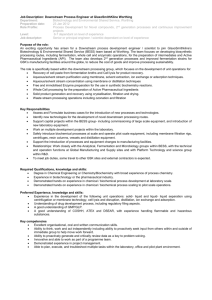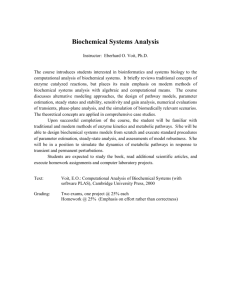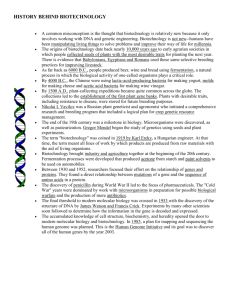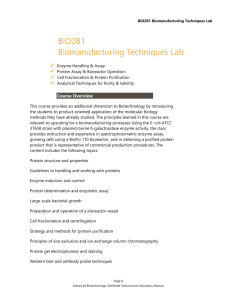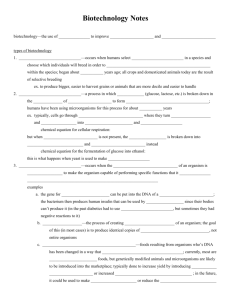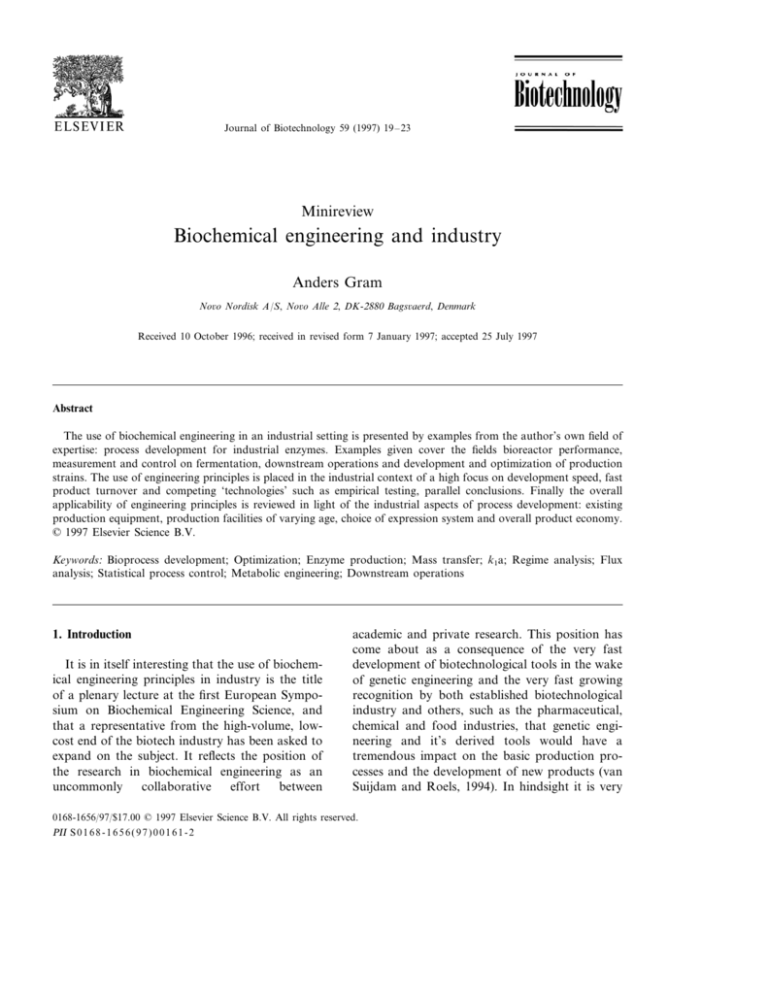
Journal of Biotechnology 59 (1997) 19 – 23
Minireview
Biochemical engineering and industry
Anders Gram
No6o Nordisk A/S, No6o Alle 2, DK-2880 Bags6aerd, Denmark
Received 10 October 1996; received in revised form 7 January 1997; accepted 25 July 1997
Abstract
The use of biochemical engineering in an industrial setting is presented by examples from the author’s own field of
expertise: process development for industrial enzymes. Examples given cover the fields bioreactor performance,
measurement and control on fermentation, downstream operations and development and optimization of production
strains. The use of engineering principles is placed in the industrial context of a high focus on development speed, fast
product turnover and competing ‘technologies’ such as empirical testing, parallel conclusions. Finally the overall
applicability of engineering principles is reviewed in light of the industrial aspects of process development: existing
production equipment, production facilities of varying age, choice of expression system and overall product economy.
© 1997 Elsevier Science B.V.
Keywords: Bioprocess development; Optimization; Enzyme production; Mass transfer; k1a; Regime analysis; Flux
analysis; Statistical process control; Metabolic engineering; Downstream operations
1. Introduction
It is in itself interesting that the use of biochemical engineering principles in industry is the title
of a plenary lecture at the first European Symposium on Biochemical Engineering Science, and
that a representative from the high-volume, lowcost end of the biotech industry has been asked to
expand on the subject. It reflects the position of
the research in biochemical engineering as an
uncommonly
collaborative
effort
between
academic and private research. This position has
come about as a consequence of the very fast
development of biotechnological tools in the wake
of genetic engineering and the very fast growing
recognition by both established biotechnological
industry and others, such as the pharmaceutical,
chemical and food industries, that genetic engineering and it’s derived tools would have a
tremendous impact on the basic production processes and the development of new products (van
Suijdam and Roels, 1994). In hindsight it is very
0168-1656/97/$17.00 © 1997 Elsevier Science B.V. All rights reserved.
PII S 0 1 6 8 - 1 6 5 6 ( 9 7 ) 0 0 1 6 1 - 2
20
A. Gram / Journal of Biotechnology 59 (1997) 19–23
fortunate that both academia and industry
jumped so fast and furiously into this field of
research, the scientific level of research in both
areas is high and increasing and the results
achieved so far ensure a continued favorable investment climate in academia and industry. The
results could not have been reached without the
fruitful synergies between the two research areas.
But the research field is maturing in these
years and it becomes increasingly important to
formulate common strategies for future research
to ensure that the results achieved continue to
be seen as value adding relative to the investment by government and private enterprise. If
common strategies are not formulated and pursued the research field will very likely end up
suffering from ‘volume sickness’, a common disease in industry when an industrial success is
pursued into too many diverse fields. The result
is invariably that the costs skyrocket and the
results materialize less quickly. When the absolute size of the costs is large enough to attract
attention, they are slashed regardless of the
benefits in the pipeline.
This paper will deal with one of the major
weaknesses in biochemical research, which is
also one of the major remaining opportunities.
The synergy between molecular biology and biochemistry on one side and chemical engineering
on the other is still not fully utilized. We may
be starting to speak the same language, but we
still have a way to go before the full advantage
is seen. The necessity of ensuring a steady flow
of applicable results from research is highly recognized in industry. Not so much so in the academic world, at least not on the same short
time horizon as in industry. But when a research field is strongly dependent on collaboration the demand for results merge into a
common paradigm for the two research areas.
This fact needs to be taken into account when
planning a strategy for future research. In the
following a series of examples of the application
of biochemical engineering science at Novo
Nordisk will be given. Finally a suggestion for a
common strategy to tie together biochemical engineering research will be given.
2. Bioreactor performance; aeration and agitation
It is natural for a fermentation based company to work seriously with bioreactor performance. We have done so for many years and
we have to admit that the concrete results have
been limited. Consequently, we are investigating
the underlying parameters thoroughly so that
we are able to build a model or a skeleton of
understanding into which we then put specific
result. The benefit of this approach as compared
to many previous attempts to increase mass
transfer, mixing and heat transfer capacity at
the same time in totally new bioreactor designs
is that it is not only a tool in its own right, but
also an important tool in allowing us to synthesize experience in this field to manageable single
parameters.
In order to separate mass transfer capacity
from mixing effects, cooling capacity and process variation, we have implemented a specific
measurement of k1a (oxygen transfer capacity)
which we have used in all of our laboratory,
pilot plant and production scales under different
sets of parameters. The resulting overview is of
course a valuable tool in up- and downscaling,
it allows us to determine much more accurately
the aeration and power input needed for a
given process at a given scale. It also allows us
to test new equipment at any scale and predict
the performance of this new equipment at other
scales. In fact in model media, we find approximately 25% better k1a at the same power input
with the Scaba 6SRGT impellers than with
Rushton turbines. The next step is, of course, to
see the performance of these new impellers in a
real process. Our preliminary conclusion is a
clear tendency for the Scaba’s to deliver a better
k1a in the last part of highly viscous Aspergillus
fermentation, where the viscosity is peaking.
We still need to work with the process to
establish if the productivity can be improved,
but if and when we run into problems with
that, we know that we do not have to worry
about the k1a. Consequently we can focus on
other limitations such as mixing time, heat
transfer, etc.
A. Gram / Journal of Biotechnology 59 (1997) 19–23
3. Regime and flux analysis
When analyzing a fermentation process, a critical question is ‘which partial process is limiting?’
Substrate components, biotransformation, mixing
time, oxygen transfer, or maybe cooling. The
answer to this question points to the optimal
route for improving the process economy.
At Novo Nordisk, process development has, to
a large extend, used trial and error or to use a
finer word, ‘experience’ to find which of these
limitations we were dealing with. This has led us
down some blind alleys and we have had to
backtrack on some occasions, and it has meant
that we have a series of processes which are rather
different, because they are a result of trial and
error. An empirical development strategy also
gives poor documentation, not because of lack of
research reports as such, but because of the lack
of a framework to describe the development in a
rational way. But we have harvested results fast
and used a minimum of resources in getting competitive production economy.
Recently, however, we have begun to use bioengineering tools to generate a framework for our
process development, thus enabling a faster shift
between products expressed in the same host and
a more solid platform for the development of
fermentation processes that resemble each other.
Flux analysis has been much promoted in the
literature as an important tool in the optimization
of fermentation processes. The basic idea is to
establish a quantitative picture of all of the major
metabolic fluxes in the cell by analyzing the uptake and secretion of metabolites during the
course of a fermentation (Holms, 1986). Our experience is that with enzyme production processes, a flux analysis as such, is of little value
because it relates too specifically to the one process being scrutinized. Even more importantly, the
results that make the large difference are found in
the initial phases of the flux analysis, where the
overall skeleton understanding of the process
fluxes is generated.
Regime analysis aims at determining the rate
limiting mechanisms in large scale processes and
thus provide important understanding of the
‘scale-down’ of processes. Further on, the knowl-
21
edge that, for example, the oxygen transfer rate is,
in fact, the rate limiting mechanism becomes an
important tool in reactor design (Kossen and
Oosterhuis, 1985).
We have performed a regime analysis on one of
our Aspergillus fermentations at production scale.
From the analysis it is evident that the dominating characteristic time is mixing time, leading to
several related problems, e.g.
Substrate consumption is fast and it is likely
that there are substrate gradients and consequently starvation in large regions of the tank.
Gas residence is short, the available oxygen is
not consumed efficiently (this is also a consequence of substrate depletion or starvation).
The consequence of these findings is that the
scale down of this process is difficult, one has to
simulate the gradients to get a representative
small scale process. A further consequence is to
investigate thoroughly the mixing patterns in the
bioreactor with the aim of improving the impeller
design, the morphology of the fungus or the rheology of the medium to decrease mixing times.
4. Measurement and control; statistical process
control
When a fermentation is running in pilot or
production plants, data from 10–15 online measurement devices is collected. Sampling time
ranges from 10 s to 30 min. A long fedbatch
fermentation will result in more than 100 000 data
points. At Novo Nordisk, the large products are
produced in more than 300 single batches every
year For each batch there are several discrete data
points as well, e.g. batch numbers on raw materials, data from propagation steps, etc. On top of
that comes traditional chemometrics, e.g. IR and
fluorescence spectroscopy to further characterize
the individual runs.
The positive problem is how to deal with this
wealth of data. The traditional answer is that
process operators and supervisors occasionally
look at a screen with the online data for the batch
that is running. When looking at a complex picture we can concentrate on 3–4 elements at the
same time. When remembering sets of complex
22
A. Gram / Journal of Biotechnology 59 (1997) 19–23
pictures, we can hold 6 – 7 images in the human
RAM at the same time. The experienced operator
or supervisor will have decided which 3 – 4 parameters are most important to keep track of, and in an
unusual situation, he will be able to draw on 6 – 7
previous batches to explain the occurrence and
decide on appropriate action. This is pretty good,
but it is not enough.
Consequently we are looking at ways to better
utilize the huge experience which is being collected.
Currently we are focusing on statistical tools, for
example PLS (projection to latent structures) (McGregor et al. 1994). All the data, for example, for
50 batches are collected in a 3-dimensional matrix.
The matrix is unfolded for ease of handling and
related to a matrix describing one or more quality
variables (e.g. final product concentration, final
yield or final product economy) for the same
batches.
The outcome is a model that, based on available
variables, can predict the quality of the batch under
surveillance. This model has immediate uses: In the
control room, the screen will at all times show a best
prediction of the quality of a batch in process. This
will be a great help for the operators allowing them
to concentrate on the batches with the most severe
problems. The screen will also be able to show 2 – 3
derived variables (latent structures) for a given
batch. These variables will be conglomerates of
several online variables, and we know from the
analysis that they are the most important for the
final outcome. With a little bit of experience, the
operator learns which physical actions to take to
correct the derived variables. One may, for example, be dominated by agitation and aeration and the
operator can increase the aeration rate and in a few
hours see the derived variable back in control and
the predicted outcome of the batch improving. This
last part also allows us to do a causal analysis on
the poorly performing batches. We can see which
of the most important variables is the hardest to
control and from that concentrate our process
development on the underlying variables.
5. Metabolic engineering; isopenicillin N synthase
When working with the biosynthetic pathway for
penicillin and from analysis of metabolic flux it was
possible to hypothesize that isopenicillin N synthase (or cyclase) activity was a limiting step
(Nielsen, 1994). The gene encoding for the cyclase
was put under control of the same promoter as the
preceding step in the penicillin synthesis pathway,
the ACV synthetase. We found that, indeed, the
resulting strain produced higher levels of cyclase
and that the penicillin production started earlier
and proceeded to a higher end titer than the mother
strain. There are many other examples available in
the open literature, the most obvious being the
work by several groups on amino acid production.
Very significant productivity improvements have
been achieved (Krämer, 1996).
For Novo Nordisk, the primary target is obviously the expression of proteins, specifically enzymes. Metabolic engineering to increase specific
production of proteins is a difficult discipline, and
as it has been hinted above, we often find that the
bottleneck for productivity is not the organism
itself but our understanding of the needs of the
organism. In other words, many of the enzyme
production processes are not as well understood
and optimized as the penicillin and amino acid
production processes. We are, however, confident
that optimization of the production organism in
concert with the optimization of process and equipment is the optimal way of improving our processes. Metabolic engineering is seen as an
increasingly important tool in the optimization of
production organisms.
6. Downstream operations; drum filtration
Fermentation and microbiology dominate the
examples of use of engineering principles. This
reflects very well the focus that Novo Nordisk has
had and which is also predominant in academia.
But when looking at the cost structure of enzyme
production it should probably be revised. The full
manufacturing cost of an enzyme is typically split
as follows:
25% Fermentation
25% Recovery
25% Formulation
10% Packaging
15% Sales costs.
A. Gram / Journal of Biotechnology 59 (1997) 19–23
The 25% recovery cost consists of many items,
prominently: recovery yield, raw material usage,
waste streams and manning. These important features are interconnected in a very complex way. A
model describing this interconnection would be
very valuable, but would also have to include
more detailed models of the unit operations employed in a given operation. This is what slows
down progress in this field. The unit operations
that we work with are not described to the level
necessary for a plausible model to be developed of
their performance on the product of industrial
fermentation. We are, however, working with
some of the unit operations, e.g. vacuum drum
filtration, were we have generated a macroscopic
model of the capacity and recovery yield of a filter
as a function of the controllable variables. These
include rotation speed of the drum, precoat thickness, knife increment per rotation. But characteristically, the model does not include important
features on the biological side, e.g. specific or
unspecific binding of the enzyme to the filter
precoat material, the flow effects of final medium
rheology or the morphology of the production
organism. The process engineers struggle to understand the consequences of enzyme chemistry,
antifoam, substrate components, salts, pH, temperature, etc. on complex results such as drum
filter capacity. In conclusion, there is a huge
potential for increased understanding of the interaction between biochemistry and stainless steel for
all the relevant unit operations in enzyme production.
7. Conclusion
There are still huge gaps in our understanding
of the synergies between biology/biochemistry and
stainless steel. All the model work, be it black-box
.
23
or structured, should be fitted into a common
framework or skeleton so that it is more readily
applicable. This will lead to much better work
because the hypotheses of the models can be
verified or discarded rapidly. If we can do this,
then we will also see engineering tools being used
more and more over the coming years, because
the benefits will match the efforts. Industry will be
able to get more products on the market and
create totally new biochemical products, because
production economy will be less of an obstacle.
Academia will get valuable insights because of the
rapid testing of hypotheses and will be able to
formulate new areas of research which will be
supported by industry. The quest is for understanding the complexities. The treasure chest
holds faster product development and a strengthened biochemical industry through better process
economy. It also holds a continued fruitful collaboration between industry and academia in biochemical engineering.
References
Holms, W. H., 1986. The central metabolic pathways of
Eschericia coli: relationship between flux and control at a
branch point, efficiency of conversion to biomass, and
excretion of acetate. Curr. Top. Cell Regul. 28, 69 – 105.
Kossen, N.W.F., Oosterhuis, N.M.G., 1985. Modelling and
scaling-up of bioreactors. In: Brauer, H. (Ed.), Biotechnology, vol. 2. VCH, Weinheim.
Krämer, R., 1996. Minireview, Genetic and physiological approaches for the production of amino acids. J. Biotechnol.
45, 1 – 21.
McGregor, J.F., Jaeckle, C., Kipparides, C., Koutoudi, M.,
1994. Process monitoring and diagnosis by multiblock PLS
methods. AIChE J. 40 (5), 826 – 838.
Nielsen, J., 1994. Physiological engineering aspects of Penicillium chrysogenum PhD Thesis, DTU.
van Suijdam, J.C., Roels, J.A., 1994. Stratigies of biotechnological industries, biotechnology in the nineties: Back to
business. ECB6: Proc. 6th European Congress on Biotechnology. Elsevier, Amsterdam, pp. 51 – 56.

